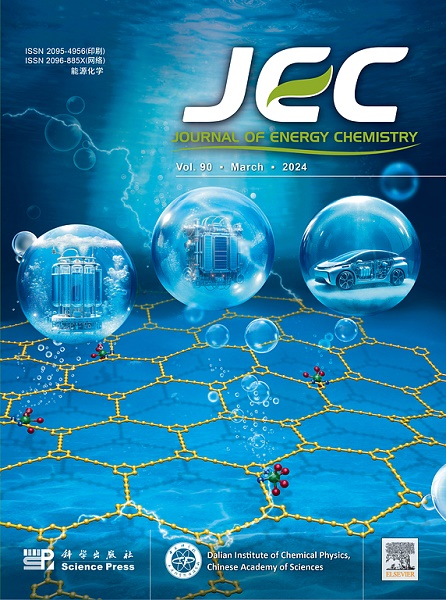Understanding the interatomic electron transfer effect on boosting electrocatalytic water splitting over Nd-Co3O4 nanosheets self-supporting electrode
IF 13.1
1区 化学
Q1 Energy
引用次数: 0
Abstract
Regulating the orbital spin-electron filling of metal centers via interatomic electron transfer in transition metal oxides is one promising approach to enhancing their electrocatalytic oxygen evolution reaction (OER) performances, while it is still a challenge due to lacking of efficient strategy and deep understanding. In this work, a facile strategy containing electrochemical deposition and annealing in air atmosphere has been proposed to introduce monodispersed neodymium (Nd) atoms into spinel Co3O4 nanosheets to trigger the electron transfer. Accordingly, the as-prepared Nd doped Co3O4 nanosheets (Nd/Co3O4) on nickel foam or carbon cloth showed greatly enhanced OER performances, with low overpotential of 284 and 396 mV at 10 mA cm−2, small Tafel slope of 95 and 119 mV dec−1 in 1.0 M KOH and 0.5 M H2SO4, respectively. The experimental and density function theory results coherently indicate that the charge transfer in the Nd-O-Co asymmetric configuration not only enhances the conductivity of Co3O4, but also regulates the filling degree of eg orbitals of Co, leading to higher spin states, optimized adsorption ability, and accelerated H2O dissociation process, thus achieving boosted OER activity.

求助全文
约1分钟内获得全文
求助全文
来源期刊

Journal of Energy Chemistry
CHEMISTRY, APPLIED-CHEMISTRY, PHYSICAL
CiteScore
19.10
自引率
8.40%
发文量
3631
审稿时长
15 days
期刊介绍:
The Journal of Energy Chemistry, the official publication of Science Press and the Dalian Institute of Chemical Physics, Chinese Academy of Sciences, serves as a platform for reporting creative research and innovative applications in energy chemistry. It mainly reports on creative researches and innovative applications of chemical conversions of fossil energy, carbon dioxide, electrochemical energy and hydrogen energy, as well as the conversions of biomass and solar energy related with chemical issues to promote academic exchanges in the field of energy chemistry and to accelerate the exploration, research and development of energy science and technologies.
This journal focuses on original research papers covering various topics within energy chemistry worldwide, including:
Optimized utilization of fossil energy
Hydrogen energy
Conversion and storage of electrochemical energy
Capture, storage, and chemical conversion of carbon dioxide
Materials and nanotechnologies for energy conversion and storage
Chemistry in biomass conversion
Chemistry in the utilization of solar energy
 求助内容:
求助内容: 应助结果提醒方式:
应助结果提醒方式:


